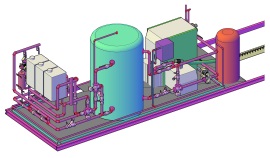
by Brianna Crandall — November 7, 2014—The U.K.-based Chartered Institution of Building Services Engineers (CIBSE) is making its new publication, AM15: Biomass Heating , available as a no-cost download following its launch at the National Woodfuel Conference in October.
Biomass has become one of the key low-carbon technologies expected to help the U.K. achieve its tough 2020 carbon reduction targets, but this emerging industry has been hampered by a lack of specialist expertise and comprehensive technical guidance, notes CIBSE.
A Carbon Trust report in 2012 stated that many large construction projects treat biomass systems like standard gas boiler installations, the end result being failure to achieve expected cost and carbon savings. According to the Carbon Trust, a survey in 2010 revealed that only 30% of installations were working well. Even more seriously, this lack of knowledge is compromising safety—with dangers ranging from explosions due to buildup of flue gases, to carbon monoxide poisoning and farmer’s lung, adds CIBSE.
This new publication is designed to tackle these risks and poor performance by providing detailed guidance on the fundamental engineering principles and practices necessary to design, install and operate safe, effective and economic biomass systems.
AM15 clearly defines roles and responsibilities throughout the lifecycle of a biomass project, from feasibility studies and procurement through to operation and maintenance. It concentrates on biomass systems with biomass boiler outputs in the range of 50 kilowatts (kW) to 5 megawatts (MW) burning woodchips or wood pellets.
The publication describes how to achieve the performance-in-use to be expected of a competent biomass heating system:
- Biomass fuel provides >90% of annual heat requirement;
- Biomass boiler seasonal efficiency is >85%;
- Biomass boiler (annual hours) utilization factor is >15%;
- Ash produced is less than 1% of fuel consumed; and
- Boiler operates for long periods without glass crowns or clinker at the fire bed.
Colin Ashford, Chair of the Publication Steering Committee, commented, “Biomass is an exciting and important emerging technology. This publication identifies the features and requirements of installations that are known to work well, based on practical experience combined with close attention to building physics. AM15 supports cost-optimized specification and design, the use of efficient and controllable systems, and well-engineered flue arrangements. It should therefore provide the platform for a step-change in the biomass heating industry.”
According to the publication, the major application areas for biomass boilers will be for heating systems for existing buildings, and those with substantial heating and hot water loads throughout the year. Batch-fed boilers are briefly mentioned, but it does not cover hot-air heaters, biomass gasifiers or biomass CHP systems. The primary readership of the manual is intended to be professional building services engineers in the U.K.
Low-carbon-related legislation and regulations are changing rapidly, and also vary significantly country by country. Reference is made throughout this manual to the U.K.’s Renewable Heat Incentive (RHI) program, and guidance is provided on measures that may be required to secure accreditation under the non-domestic RHI. Those installing boilers to provide heat to domestic properties should refer to the domestic RHI guidance on the U.K.’s Office of Gas and Electricity Markets (OFGEM) Web site.
CIBSE acknowledged the extensive support of the Carbon Trust for the early draft, and the contribution of the initial authors. The lead author was David Palmer of Campbell Palmer Partnership, with contributing authors Colin Ashford, Jim Kinnibrugh and Graham Smith.





